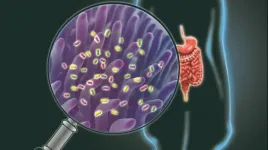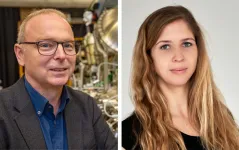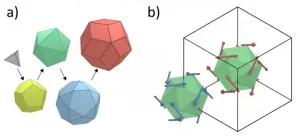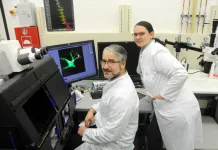How metal atoms can arrange themselves on an insulator
Bielefeld researchers publish study in Nature Communications
2021-02-04
(Press-News.org) In order to produce tiny electronic memories or sensors in future, it is essential to be able to arrange individual metal atoms on an insulating layer. Scientists at Bielefeld University's Faculty of Chemistry have now demonstrated that this is possible at room temperature: molecules of the metal-containing compound molybdenum acetate form an ordered structure on the insulator calcite without jumping to other positions or rotating. Their findings have been presented in the Nature Communications journal. The work was done in cooperation with researchers from the universities of Kaiserslautern, Lincoln (UK) and Mainz.
'Until now, it has been difficult to arrange metal atoms on an insulator surface. It's easier on a metal surface, but that's not of much benefit for use in electronic components,' says Professor Dr Angelika Kühnle, who heads the Physical Chemistry I working group at the Faculty of Chemistry. 'That's what's special about our study: we've found a way to arrange metal atoms on insulators in a lattice-like structure.' Insulators are materials in which electrons cannot move freely and are therefore very poor conductors of electricity.
The difficulty is in robustly anchoring metal atoms even at room temperature - without them attracting each other, jumping to other positions or rotating. Until now, scientists have been able to arrange small molecules on insulators at very low temperatures, but at room temperature they were too mobile. Larger molecules solved the problem of mobility, but quickly formed clusters.
For their research, Kühnle and her working group used molybdenum acetate, a compound that contains two atoms each of the metal molybdenum. The fact that this compound shows interesting structural properties on a gold surface had previously been discovered by a research team from the Technical University of Kaiserslautern. 'If molybdenum acetate is now applied to a calcite surface, the molecules form an ordered structure. This means that the molybdenum atoms are also arranged in an ordered array,' says Dr Simon Aeschlimann, who conducted research in Kühnle's group and is lead author of the published study. 'By means of various experiments and simulations, we were able to show that the molybdenum acetate molecules neither jump nor rotate, nor do they form clusters. They are firmly anchored on the calcite surface.'
The scientists conducted the experiments with the aid of an atomic force microscope. 'In atomic force microscopy, a tiny needle scans the surface of materials - like a record player, except that the needle does not touch the surface directly, but is deflected by atomic forces. This then creates an image of the surface structure,' says Aeschlimann. The scientists examined, for example, where the molybdenum acetate molecules are located on the calcite surface and in which direction they align themselves.
The ordered structure is created because the molybdenum acetate molecules align themselves precisely with the charge distribution on the calcite surface. Calcite consists of calcium and carbonate building blocks that form a regular lattice structure. 'Each molybdenum acetate molecule fits only in a very specific place on the calcite surface and at the same time does not interact with its neighbouring molybdenum acetate molecules. That means it is firmly anchored,' says Kühnle.
As a scientist engaged in pure research, Kühnle is interested in the question of how molecular structures form on surfaces or interfaces. But the results are also relevant for electronic applications: if, for example, magnetic metals can be arranged according to the same principle, this could be used in nanotechnology to produce data storage - i.e. memories that are only a few millionths of a millimetre in size. Other possible areas of application include optical or chemical sensors.
INFORMATION:
Original publication:
Simon Aeschlimann, Sebastian V. Bauer, Maximilian Vogtland, Benjamin Stadtmüller, Martin Aeschlimann, Andrea Floris, Ralf Bechstein, Angelika Kühnle: Creating an Array of Metal-Complexing Molecules on an Insulator Surface at Room Temperature. Nature Communications, https://doi.org/10.1038/s41467-020-20189-x, published on 21 December 2020.
Contact:
Professor Dr Angelika Kühnle, Bielefeld University
Faculty of Chemistry
Telephone: +49 521 106-2045
Email: angelika.kuehnle@uni-bielefeld.de
[Attachments] See images for this press release:
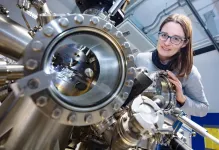
ELSE PRESS RELEASES FROM THIS DATE:
2021-02-04
A healthy person has a general balance of good and bad bacteria. But that balance is thrown off when someone gets sick. So, to help boost their levels of good bacteria, many people take probiotic supplements -- live bacteria inside of a pill. Various commercial probiotic supplements are available for consumer purchase, and while health experts generally agree about their overall safety, controversy surrounds their efficacy.
Inside the human body lives a large microscopic community called the microbiome, where trillions of bacteria engage in a constant "tug of war" to maintain optimal levels of good and bad bacteria. Most of this struggle takes place within the body's gastrointestinal tract, as bacteria help with digesting food and support the immune system. Although ...
2021-02-04
New research carried out by City data scientist, Dr Andrea Baronchelli, and colleagues, into the dark web marketplace (DWM) trade in products related to COVID-19, has revealed the need for the continuous monitoring of dark web marketplaces (DWMs), especially in light of the current shortage and availability of coronavirus vaccines.
In their paper, Dark Web Marketplaces and COVID-19: before the vaccine published in the EPJ Data Science journal, Dr Baronchelli and his colleagues analysed 851,199 listings extracted from 30 DWMs between January 1, 2020 and November 16, 2020 before the advent of the availability of the coronavirus vaccine.
They identify 788 listings directly related to COVID-19 products and monitor the temporal evolution of product categories including Personal Protective ...
2021-02-04
Researchers from the University of Missouri School of Medicine have discovered that children who receive a seasonal flu shot are less likely to suffer symptoms from a COVID-19 infection. The finding comes from a review of more than 900 children diagnosed with COVID-19 in 2020.
"It is known that the growth of one virus can be inhibited by a previous viral infection," said Anjali Patwardhan, MD, professor of pediatric rheumatology and child health. "This phenomenon is called virus interference, and it can occur even when the first virus invader is an inactivated virus, such as the case with the flu vaccine."
Patwardhan reviewed records from 905 pediatric patients diagnosed with COVID-19 between February and August 2020 to determine each patient's influenza vaccination history. ...
2021-02-04
Cardiac patients who also have diabetes will be able to do their rehabilitation exercises more safely, thanks to the world's first guidance on the subject, which has been published by international experts including a Swansea University academic.
The guidance will be a crucial resource for healthcare professionals, so they can help the growing number of cardiac rehabilitation patients who also have diabetes.
The guidance, approved by international diabetes organisations, was drawn up by a team including Dr. Richard Bracken of the School of ...
2021-02-04
Scientists at Bielefeld University's Faculty of Physics have succeeded for the first time in imaging the SARS-CoV-2 coronavirus with a helium ion microscope. In contrast to the more conventional electron microscopy, the samples do not need a thin metal coating in helium ion microscopy. This allows interactions between the coronaviruses and their host cell to be observed particularly clearly. The scientists have published their findings, obtained in collaboration with researchers from Bielefeld University's Medical School OWL and Justus Liebig University Giessen, in the Beilstein Journal of Nanotechnology.
'The study shows that the helium ion microscope is suitable for imaging coronaviruses - so precisely that the interaction between virus ...
2021-02-04
People undergoing long-term dialysis are almost 4 times more likely to die from COVID-19 and should be prioritized for vaccination, found a new Ontario study published in CMAJ (Canadian Medical Association Journal).
"As the COVID-19 pandemic proceeds, focused efforts should be made to protect this population from infection including prioritizing patients on long-term dialysis and the staff treating them for SARS-CoV-2 vaccination," writes Dr. Peter Blake, provincial director, Ontario Renal Network, Ontario Health, and professor, Schulich School of Medicine and Dentistry, Western University, ...
2021-02-04
It is necessary to develop additional COVID-19 vaccines, as different vaccine approaches have their advantages and disadvantages and may work synergistically. Researchers at Karolinska Institutet in Sweden now report that they have developed a prototype vaccine against SARS-CoV-2 using a DNA vaccine platform that is inexpensive, stable, easy to produce, and shows a good safety profile. A study published in Scientific Reports shows that the vaccine induces potent immune responses in mice.
The vaccine, called DREP-S, is administered as DNA and is based on a DNA-launched self-amplifying RNA (DREP) platform developed at Karolinska ...
2021-02-04
Between chemistry classes, gemstones, and electronics, the idea of crystals, substances with an ordered and periodic arrangement of atoms is quite common. But about 40 years ago, a strange particle was discovered by scientists that hasn't become commonplace in our world yet: quasicrystals. These are structures with curious atomic arrangements, which, while superficially similar to crystals, lack periodicity despite being ordered. Because of their structures, quasicrystals exhibit symmetries forbidden to crystals and are endowed with interesting properties that crystals cannot show, ...
2021-02-04
The unmet HIV prevention and treatment needs of female sex workers and especially their male clients could contribute substantially to ongoing HIV transmission in South Africa, according to a new study led by researchers at the University of Bristol, UK.
The researchers used mathematical modelling to look at the contribution of commercial sex, sex between men, and other heterosexual partnerships to HIV transmission in South Africa.
They found that, over a ten-year period (2010-19), sex between female sex workers and their paying clients contributed 6.9 per cent of new HIV infections, while ...
2021-02-04
In order to fight pathogens, mast cells regulate inflammatory reactions of the immune system. Both mast cells and neutrophils are white blood cells and are critical for the body's immune defense. A team of scientists around the immunologist Prof. Dr. Anne Dudeck and the bioengineer Jan Dudeck has discovered a crucial aspect of the communication between mast cells and neutrophils. These new findings may allow for developing innovative, targeted therapeutic strategies to dampen allergic responses and inflammatory reactions. The results have been published ...
LAST 30 PRESS RELEASES:
[Press-News.org] How metal atoms can arrange themselves on an insulator
Bielefeld researchers publish study in Nature Communications

